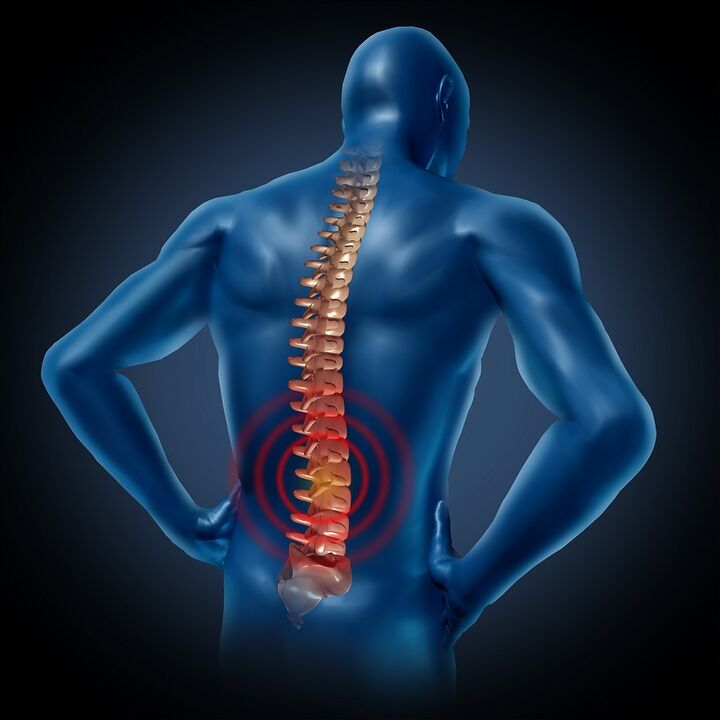Back pain is a little less common than headaches. Every adult has this feeling at least once. Often, the neck and lower back are affected. Doctors associate it with a gradual decrease in a person’s physical activity, as many people work and relax at the computer. This is the cause of chronic degenerative diseases of the musculoskeletal system, which is the most common cause of back pain. Timely examination and treatment, regular physical activity and normalization of weight will help relieve discomfort and restore the joy of movement.

general information
The incidence of high back pain is associated with anatomy. Its base is the spinal space. The cartilaginous disc is located between the vertebrae, which performs the function of absorbing shock. Additional skeletons are provided by muscles and ligaments. The spinal cord enters the spinal space, from where the paired roots elongate, accommodating almost all organs and tissues.
Pathological processes on any dorsal structure, as well as internal organs associated with it by nerve fibers, can cause pain. Often, doctors need to make a thorough diagnosis to find out the source.
The reasons
A large number of conditions that cause pain in the back are chronic. They start gradually and are asymptomatic for a long time.
Among the external and internal causes that can cause deterioration, the most common are:
- increased load on the spine with a background of weight gain or overweight;
- metabolic disorders;
- postural disorders and diseases of the musculoskeletal system (for example, arthrosis of the hip joint or flat foot), which lead to uneven load distribution;
- hypothermia;
- infectious and autoimmune inflammatory processes;
- volumetric formations (tumors, abscesses);
- pathology of the internal organs of the chest or abdominal cavity.
Disease
Back pain can be a symptom of many diseases that can be divided into several groups.
Pathology of the spine or joints
This is the most common cause of back pain. A large number of diseases are associated with high and / or uneven loads on the spinal space:
- osteochondrosis: the cartilage disc between the vertebrae begins to collapse, thin and is replaced by bone tissue; as a result, the degenerative function of the spine suffers, and the spinal cord or its roots are often compressed;
- intervertebral hernia: the middle part of the intervertebral disc protrudes towards the spinal cord, squeezing it; problems often arise against the background of advanced osteochondrosis;
- ankylosing spondylitis: autoimmune inflammation of the joints and ligaments of the spine, causing painful spasms of the surrounding muscles; over time, it becomes the cause of joint vertebral joints;
- spondylolisthesis: displacement of the vertebrae from its normal position, which can cause compression of the root or spinal cord;
- rheumatoid arthritis: inflammation of the joints of an autoimmune nature; more often affects the cervical spine;
- osteomyelitis: inflammation of bone tissue.
Muscle tissue pathology
Muscle tissue is often involved in pathological processes in the pathology of bone or joint tissue. In this case, painful cramps appear in the affected area. In addition, pain can occur against the background of:
- fibromyalgia: chronic pain in muscles and ligaments, often accompanied by stiffness and stiffness;
- myositis: an inflammatory process in the muscles that occurs against the background of hypothermia, stretching, injury or physical exertion;
- dermatomyositis: chronic damage to the skin, muscles and internal organs, possibly of an autoimmune nature.
Spinal cord and root pathology
Often, pain occurs against the background of compression of certain areas of nerve tissue due to trauma, tumors, osteochondrosis or disc herniation. Isolated lesions can be provoked by:
- infection -related inflammation, including HIV and syphilis;
- multiple sclerosis;
- bleeding;
- lack of oxygen;
- vitamin or mineral deficiency.
Pathology of internal organs
The preservation of most of the internal organs is done by the roots of the spinal cord. As a result, any pathological process in it can be a cause of back pain. Often, doctors face the following problems:
- renal pathology: pyelonephritis, urolithiasis;
- inflammation of the pelvic organs: salpingitis, salpingo-oophoritis, prostatitis;
- pathology of the bile duct: cholecystitis, cholelithiasis;
- damage to the cardiovascular system: angina pectoris, heart attack, dissection of aortic aneurysms, pulmonary embolism;
- respiratory system diseases: pleurisy, pneumonia, abscesses, pneumothorax;
- appendix.
Nature and localization of pain
The localization and nature of the sensation can tell a lot about its source. It is important to tell the doctor in as much detail as possible about how back pain is, so that he or she can identify the cause and get treatment as soon as possible.
Depending on its nature, the pain may be:
- acute: often occurs against the background of osteochondrosis, intervertebral hernia, lumbago or radiculitis, usually exacerbated by movement;
- pain: characteristic of chronic inflammatory processes in muscles, ligaments or internal organs;
- pressing or ruptured: most often speaks of acute or chronic pathology of internal organs;
- throbbing, strong: usually associated with trauma, lumbago, spondylosis, exacerbation of osteochondrosis.
Localization of pain syndrome can also help diagnose:
- on the right: pathology of the liver, gallbladder, duodenum, damage to the ovaries or kidneys on the right, appendicitis;
- left: pathology of the spleen, left kidney or ovary, myocardial infarction, pancreatitis;
- in the lumbar region: sciatica, osteochondrosis, lumbago, Reiter's syndrome, intervertebral hernia;
- below the waist: osteochondrosis or intervertebral hernia, bilateral ovarian inflammation, uterine pathology, cramps during menstruation;
- below the right scapula: pathology of the liver, gallbladder, pancreas, right side intercostal neuralgia, pleurisy, pneumonia;
- below the left shoulder blade: heart disease, left sided pneumonia, pleurisy, intercostal neuralgia, etc.
When you need to see a doctor right away
Back pain can be a sign of a harmless pathology, and evidence of a dangerous process that requires immediate medical treatment. One should immediately see a specialist in the following situations:
- pain occurs after injury;
- it is impossible to find a position where the pain is getting weaker;
- there is an increase in temperature;
- signs of nerve damage appear: numbness, tingling, muscle weakness;
- pain worse at night;
- sensation accompanied by weakness, darkness in the eyes, palpitations, cold sweats;
- pain relievers do not provide relief;
- the disease persists despite treatment;
- blood pressure has changed dramatically (increased or decreased);
- you have trouble urinating or the color of your urine has changed;
- the pain has spread to the chest, abdomen;
- the condition is accompanied by nausea, vomiting, loose or delayed stools
In general, any suspicious symptoms not observed in a previous pain attack should alert the patient and be a reason to seek immediate medical attention.
Diagnostics
Back pain examinations include:
- collection of complaints and anamnesis of the disease, explanation of the state of onset of pain, its nature, intensity, localization and other important parameters, identification of risk factors for various diseases;
- general examination with measurement of blood pressure, assessment of heart rate, respiration, temperature;
- neurological examination: assessment of sensory and motor function, reflex quality;
- laboratory diagnostics: general blood and urine tests, basic biochemical blood examination; if necessary, tests are prescribed to confirm or exclude specific pathologies;
- ECG, cardiac ultrasound;
- X-ray, CT or MRI of the spine;
- Ultrasound of the organs of the abdominal cavity, small pelvis;
- chest x-ray;
- Doppler ultrasonography of the cervical canal and brain;
- electromyography: assessment of the quality of the conduction of nerve impulses through muscle fibers;
- narrow specialist consultation: nephrologist, cardiologist, gynecologist, etc.
The list of tests, diagnostic procedures and consultations may vary depending on the patient’s complaint.

Treatment of back pain
The choice of treatment method depends on the cause. Often, doctors are faced with pathology of the musculoskeletal system and nervous tissue. In this case, painkillers form the basis of therapy:
- non-steroidal anti-inflammatory drugs;
- hormonal agents;
- muscle relaxation: to relieve muscle spasms;
- Vitamin B: to improve the condition of nerve tissue;
- narcotic analgesics: with the effectiveness of drugs from other groups.
Additional procedures help increase the effect of drug treatment:
- physiotherapy: electro- and phonophoresis, laser and magnetic therapy, electroneurostimulation;
- massage;
- manual therapy;
- physiotherapy.
The specific technique chosen by the doctor depends on the cause and individual characteristics of the organism. In some cases, surgical treatment is prescribed.
prevention
Back pain can be prevented. To do this, you must follow the following rules:
- prevent hypodynamia: do gymnastics, play sports (without overdoing it);
- avoid stress;
- rest well;
- eat properly, prevent excessive weight gain;
- avoid lifting weights;
- correct posture disorders;
- checked regularly by a doctor, treating chronic diseases in a timely manner.
Back pain can be subtle, or can completely paralyze a person. Do not allow a crisis to occur, see a doctor at the first sign of trouble.

















































